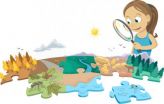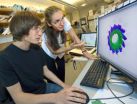(Press-News.org) The Arizona State University online children's science portal, "Ask A Biologist," provides the backdrop for an editor's pick in the Oct. 12 online edition of Public Library of Science (PLoS).
In the article "Ask A Biologist: Bringing Science to the Public," ASU's Charles Kazilek, the creative force behind the popular site (with a million or more visitors each year), points to the power of providing science education in a format that the public, quite literally, asks for.
Many of the 2,500 pages of educational content available on the "Ask A Biologist" website have grown directly from requests or queries from users. Using the simple question and answer form – the "Ask a" in "Ask A Biologist" – Kazilek (known as Dr. Biology in cybercircles), has received more than 25,000 queries from parents, students, teachers and life-long learners about all aspects of biology.
"A key-stroke can bring the world to one's laptop, but nothing substitutes for a living, breathing expert," says Kazilek, director for technology integration and outreach in ASU's School of Life Sciences.
The experts backing up Dr. Biology are more than 150 volunteer scholars at ASU, which include professors, graduate students and postdoctoral fellows in the School of Life Sciences and College of Liberal Arts and Sciences. The popularity of the site has also attracted an army of off-campus volunteers from around the world.
"Scientists, educators and science Web developers often don't realize that great graphics and in-depth content are only part of why 'Ask A Biologist' is popular," Kazilek says. "People still need people."
This key theme is reiterated throughout Kazilek's article in the PLoS journal. A real person not only offers insight into why the sky is blue and whether ants can see at night, the interactions between users and experts expand public understanding of who scientists are as people and, he says, alters users' relationship with cutting-edge science.
Catering to that relationship has also fueled expanded multimedia content on Kazilek's site, including a podcast competition where local public school children come to ASU to interview scientists (askabiologist.asu.edu/explore/watch_listen).
The PLoS article predicts that the role of "Ask a" websites in science learning will continue to expand. Though these sites were some of the earliest on the Net, akin to primitive search tools, Kazilek says that with investment and energy the approach is extraordinarily resilient in an electronic medium whose only static feature is change.
Kazilek points to the function that "Ask a" websites can play in helping Internet users negotiate the sheer volume and rapid change of information on the Web. "'Ask a' formats offer up-to-date information, more clearly resolve competing claims and minimize misinformation," Kazilek says.
Dr. Biology's diverse audience is proof that online science education resources have much to offer learners at multiple levels. "From 'K to gray,'" quips Kazilek. "Invest energy in something creative and fun and people will come. The key is giving them what they 'Ask a' for."
INFORMATION:
The full PLoS text can be found: http://www.plosbiology.org/article/info%3Adoi%2F10.1371%2Fjournal.pbio.1000458
Questions fuel 'Ask A Biologist' website success
Science portal offers human touch along with cutting-edge biology
2010-10-15
ELSE PRESS RELEASES FROM THIS DATE:
Unsung hero: Berkeley researchers produce high-res model of Ndc80 in action
2010-10-15
Unless you are in a field of study related to cell biology, you most likely have never heard of Ndc80. Yet this protein complex is essential to mitosis, the process by which a living cell separates its chromosomes and distributes them equally between its two daughter cells. Now, through a combination of cryo-electron microscopy and three-dimensional image reconstruction, a team of researchers with the Lawrence Berkeley National Laboratory (Berkeley Lab) and the University of California (UC) Berkeley have produced a subnanometer resolution model of human Ndc80 that reveals ...
UC Riverside physicists pave the way for graphene-based spin computer
2010-10-15
RIVERSIDE, Calif. – Physicists at the University of California, Riverside have taken an important step forward in developing a "spin computer" by successfully achieving "tunneling spin injection" into graphene.
An electron can be polarized to have a directional orientation, called "spin." This spin comes in two forms – electrons are said to be either "spin up" or "spin down" – and allows for more data storage than is possible with current electronics.
Spin computers, when developed, would utilize the electron's spin state to store and process vast amounts of information ...
Psychological first aid for survivors of disaster
2010-10-15
Even as we breathe a sigh of relief watching the rescue of 33 miners trapped in a Chilean mine for more than two months, there is recognition that their recovery from this traumatic experience involves more than just their physical health. Survivors of disasters are at significant risk for such problems as post-traumatic-stress-disorder (PTSD), depression, anxiety, and substance abuse. But research on the psychological effects of disasters indicates that the risk varies among individuals and, further, that the most common psychological interventions currently in use are ...
Push and pull get eyes to work together
2010-10-15
Researchers appear to have found a better way to correct sensory eye dominance, a condition in which an imbalance between the eyes compromises fine depth perception. The key is a push-pull training method in which the weak eye is made to work while vision in the strong eye is actively suppressed, according to a report published online on October 14 in Current Biology, a Cell Press publication.
"After a 10-day training period, we found our participants' sensory eye dominance is significantly reduced as the two eyes become more balanced," said Teng Leng Ooi of Pennsylvania ...
Of worms and women: Common causes for reproductive decline with age
2010-10-15
In worms as in women, fertility declines at a rate that far exceeds the onset of other aging signs. And now a new report in the October 15th issue of Cell, a Cell Press publication, suggests that worms' and humans' biological clocks may wind down over time for similar underlying reasons.
"For us, what's most important is that there are so many shared genes involved," said Coleen Murphy of Princeton University. "This isn't just about worms and how they reproduce." That such commonalities would exist wasn't obvious, she adds, given that reproduction in the nematode worm ...
Genetic data related to sodium-regulating hormone may help explain hypertension risk
2010-10-15
New research points to the existence of a gene on chromosome 5 that influences how much aldosterone is produced — which may be excessive in African-descended populations.
"Aldosterone was very important to their early ancestors living in the arid climate of Africa," said J. Howard Pratt, study co-author. "Dietary intake of sodium in today's world is much higher, and there may not be the need for the amount of aldosterone produced, leading to a level of sodium balance that places individuals at risk for hypertension."
Among people of African descent, plasma concentrations ...
Researchers develop method for curbing growth of crystals that form kidney stones
2010-10-15
Researchers have developed a method for curbing the growth of crystals that form cystine kidney stones. Their findings, which appear in the latest issue of the journal Science, may offer a pathway to a new method for the prevention of kidney stones.
The study was conducted by researchers at New York University's Department of Chemistry and its Molecular Design Institute, NYU School of Medicine, and the Medical College of Wisconsin.
Kidney stones comprised of L-cystine affect at least 20,000 individuals in the United States. This number is substantially smaller than ...
Flexing their muscles helps kidney disease patients live longer
2010-10-15
Kidney disease patients are healthier and live longer if they've beefed up their muscles, according to a study appearing in an upcoming issue of the Clinical Journal of the American Society Nephrology (CJASN). The results suggest that patients may benefit from pumping iron or taking medications to boost their lean body mass.
Kidney disease patients who are on dialysis live longer if they have a high body mass index (BMI); however, BMI measurements do not differentiate lean from fat mass. Kamyar Kalantar-Zadeh MD, PhD (Los Angeles Biomedical Research Institute at Harbor-UCLA ...
In childhood obesity, gene variants raise risk
2010-10-15
A new study by pediatric researchers has added to the evidence that genes have a strong influence on childhood obesity.
The study team searched across the whole genomes of thousands of obese children for copy number variations (CNVs)--deletions or duplications of DNA sequences. Although the CNVs they found are rare within the population, their data suggest that those individuals harboring such variants are at a very high risk of becoming obese.
"Our study is the first large-scale, unbiased genome-wide scan of CNVs in common pediatric obesity," said study leader Struan ...
Study uncovers genetic variations linked with common childhood obesity
2010-10-15
A new study uncovers multiple genetic variations associated with common childhood obesity. The research, published by Cell Press on October 14th in the American Journal of Human Genetics, is likely to guide future studies aimed at characterizing the affected genes and unraveling the complex biology that underlies childhood obesity.
Obesity, which has increased significantly in recent years in Western societies, is a major risk factor for type 2 diabetes and cardiovascular diseases. The majority of obese children become obese adults and adolescent obesity is associated ...
LAST 30 PRESS RELEASES:
American Meteorological Society announces new executive director
People with “binge-watching addiction” are more likely to be lonely
Wild potato follows a path to domestication in the American Southwest
General climate advocacy ad campaign received more public engagement compared to more-tailored ad campaign promoting sustainable fashion
Medical LLMs may show real-world potential in identifying individuals with major depressive disorder using WhatsApp voice note recordings
Early translational study supports the role of high-dose inhaled nitric oxide as a potential antimicrobial therapy
AI can predict preemies’ path, Stanford Medicine-led study shows
A wild potato that changed the story of agriculture in the American Southwest
Cancer’s super-enhancers may set the map for DNA breaks and repair: A key clue to why tumors become aggressive and genetically unstable
Prehistoric tool made from elephant bone is the oldest discovered in Europe
Mineralized dental plaque from the Iron Age provides insight into the diet of the Scythians
Salty facts: takeaways have more salt than labels claim
When scientists build nanoscale architecture to solve textile and pharmaceutical industry challenges
Massive cloud with metallic winds discovered orbiting mystery object
Old diseases return as settlement pushes into the Amazon rainforest
Takeaways are used to reward and console – study
Velocity gradients key to explaining large-scale magnetic field structure
Bird retinas function without oxygen – solving a centuries-old biological mystery
Pregnancy- and abortion-related mortality in the US, 2018-2021
Global burden of violence against transgender and gender-diverse adults
Generative AI use and depressive symptoms among US adults
Antibiotic therapy for uncomplicated acute appendicitis
Childhood ADHD linked to midlife physical health problems
Patients struggle to measure blood pressure at home
A new method to unlock vast lithium stores
Scientists unveil “dissolution barocaloric” cooling, opening new path to zero-carbon refrigeration
Microplastics in the atmosphere: Higher emissions from land areas than from the ocean
Metal clumps in quantum state: Vienna research team breaks records
PolyU develops new human-safe magnetorheological fibres, leading innovations in smart wearable textiles
Rice establishes Global Brain Economy Initiative in Davos, aligned with new report on brain health and AI
[Press-News.org] Questions fuel 'Ask A Biologist' website successScience portal offers human touch along with cutting-edge biology



